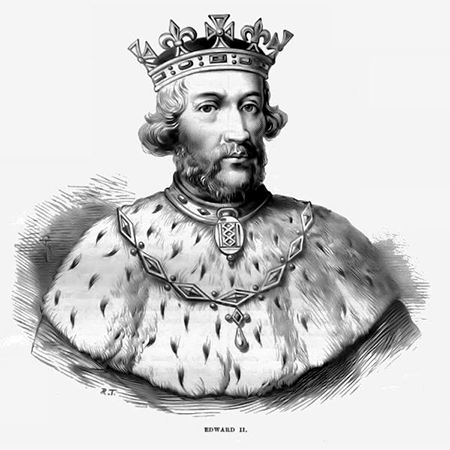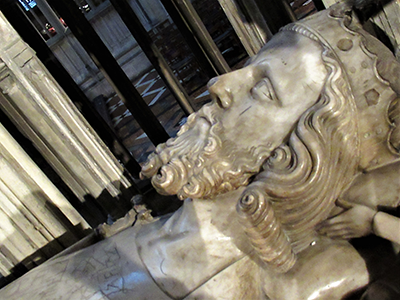



King Edward II – Quick Stats




Born: 25 April 1284
King Edward II: A Reign of Controversy, Betrayal, and Tragic Downfall
King Edward II of England, the son of Edward I and Eleanor of Castile, remains one of the most controversial monarchs in English history. His reign, from 1307 to 1327, was marked by internal conflict, failed military campaigns, and political strife, ultimately leading to his forced abdication and mysterious death.
Early Life and Accession
Born on April 25, 1284, in Caernarfon, Wales, Edward was the fourth son of Edward I but the first to survive into adulthood. Unlike his formidable father, Edward II lacked a strong military disposition and was often perceived as weak-willed and prone to manipulation. He ascended the throne in 1307 after his father's death, inheriting a kingdom embroiled in war with Scotland and internal disputes among the barons.
Born on April 25, 1284, in Caernarfon, Wales, Edward was the fourth son of Edward I but the first to survive into adulthood. Unlike his formidable father, Edward II lacked a strong military disposition and was often perceived as weak-willed and prone to manipulation. He ascended the throne in 1307 after his father's death, inheriting a kingdom embroiled in war with Scotland and internal disputes among the barons.
Relationship with Piers Gaveston
One of the earliest and most contentious aspects of Edward II’s reign was his deep and personal attachment to Piers Gaveston. Whether their relationship was merely one of friendship or something more intimate remains debated by historians.
One of the earliest and most contentious aspects of Edward II’s reign was his deep and personal attachment to Piers Gaveston. Whether their relationship was merely one of friendship or something more intimate remains debated by historians.
The Scottish king, Robert the Bruce, decisively defeated Edward’s forces, securing Scotland’s independence and dealing a significant blow to England’s military reputation. This humiliation not only weakened Edward’s standing among his own people but also emboldened his political enemies at home. Many barons lost faith in his ability to govern effectively, leading to increasing unrest and opposition. The impact of this defeat reverberated for years, weakening England's position in the broader European geopolitical landscape and eroding the monarchy’s credibility.
Died: 21 September 1327
Mother: Eleanor of Castile
Father: King Henry III of England
Wife: Isabella of France
Children:
Eleanor of Woodstock
John of Eltham
Edward III
Successor: King Edward III
Predecessor: King Edward I
Despite his failures, Edward’s rule was significant in shaping the course of English governance and politics. His tumultuous reign has been the subject of numerous historical analyses, with scholars examining the complex interplay of personal relationships, political struggles, and shifting power dynamics in medieval England.
Edward’s unwavering favoritism toward Gaveston led to significant unrest among the English nobility, who viewed the Gascon knight as an arrogant and disruptive influence. Gaveston was exiled multiple times under pressure from the barons but was always reinstated by Edward.
His return in 1312 sparked outrage, culminating in his capture and execution by a group of rebellious nobles led by the Earl of Warwick. Gaveston’s death left Edward embittered and further alienated from his nobility, creating a deep and lasting rift that would haunt his reign.
The Scottish Conflict and the Battle of Bannockburn
Edward II’s reign saw one of the most infamous military disasters in English history. Determined to assert his authority over Scotland, Edward led an army north in 1314, but his campaign ended in a crushing defeat at the Battle of Bannockburn.
Edward II’s reign saw one of the most infamous military disasters in English history. Determined to assert his authority over Scotland, Edward led an army north in 1314, but his campaign ended in a crushing defeat at the Battle of Bannockburn.
Political Turmoil and the Despenser War
Following the death of Gaveston, Edward found new confidants in Hugh Despenser the Younger and his father, Hugh Despenser the Elder. The Despensers quickly became Edward’s most trusted advisors and exerted considerable influence over the government. However, their accumulation of wealth and power angered many nobles, leading to widespread discontent.
Following the death of Gaveston, Edward found new confidants in Hugh Despenser the Younger and his father, Hugh Despenser the Elder. The Despensers quickly became Edward’s most trusted advisors and exerted considerable influence over the government. However, their accumulation of wealth and power angered many nobles, leading to widespread discontent.
This culminated in the Despenser War (1321–1322), where a coalition of barons sought to remove them from power. Initially, Edward suffered setbacks, but he managed to turn the tide and ruthlessly crushed the rebellion. The Despensers were reinstated, and their enemies faced severe reprisals, leading to an increasingly tyrannical rule that alienated even more of Edward’s subjects. The unchecked influence of the Despensers is often cited as a primary factor in Edward’s downfall, as their policies exacerbated divisions within the kingdom and further isolated the monarchy.
Downfall and Abdication
Despite his temporary victories, Edward’s reign was doomed. His greatest adversary emerged from within his own household—his wife, Isabella of France. Long estranged from her husband, Isabella aligned herself with the ambitious noble Roger Mortimer, and together they launched an invasion of England in 1326. Facing little resistance, their forces quickly overran the kingdom, forcing Edward to flee.
Despite his temporary victories, Edward’s reign was doomed. His greatest adversary emerged from within his own household—his wife, Isabella of France. Long estranged from her husband, Isabella aligned herself with the ambitious noble Roger Mortimer, and together they launched an invasion of England in 1326. Facing little resistance, their forces quickly overran the kingdom, forcing Edward to flee.
He was eventually captured and imprisoned, and in January 1327, he was coerced into abdicating in favor of his 14-year-old son, Edward III. With his reign officially over, Edward II was confined to Berkeley Castle, where he would meet a tragic fate. His capture and forced abdication marked one of the most dramatic power shifts in medieval England, as it demonstrated the increasing willingness of the nobility to directly challenge the monarchy’s authority.
Joan of the Tower


Mysterious Death
The circumstances of Edward II’s death on September 21, 1327, remain shrouded in mystery. The most commonly accepted theory is that he was murdered on the orders of Isabella and Mortimer, though the precise method of his death is debated.
The circumstances of Edward II’s death on September 21, 1327, remain shrouded in mystery. The most commonly accepted theory is that he was murdered on the orders of Isabella and Mortimer, though the precise method of his death is debated.
Some chroniclers claim he was executed in a gruesome manner involving a red-hot poker, while others suggest he may have been quietly strangled or starved. There are even theories that Edward may have escaped and lived in secret for years after his supposed death.
Regardless of the truth, his demise marked the violent end of a turbulent reign. Some modern historians believe that the stories of his cruel execution were exaggerated or fabricated to further justify his removal from power and ensure that he would not return to challenge Edward III's rule.
Tomb of King Edward II in Gloucester Cathedral
Legacy
Edward II’s reign is often remembered as one of incompetence, favoritism, and internal discord. Unlike his father, who was known for his military prowess, and his son, who became a great warrior king, Edward lacked the qualities necessary to maintain order and authority. However, his rule played a crucial role in the development of English governance. The conflicts between Edward and his barons reinforced the importance of Parliament and the growing power of the nobility in checking royal authority. His downfall also demonstrated the limitations of absolute monarchy and the risks of alienating the ruling class.
Edward II’s reign is often remembered as one of incompetence, favoritism, and internal discord. Unlike his father, who was known for his military prowess, and his son, who became a great warrior king, Edward lacked the qualities necessary to maintain order and authority. However, his rule played a crucial role in the development of English governance. The conflicts between Edward and his barons reinforced the importance of Parliament and the growing power of the nobility in checking royal authority. His downfall also demonstrated the limitations of absolute monarchy and the risks of alienating the ruling class.
Despite his failures, Edward II remains a figure of intrigue, with historians continuing to debate his personal relationships, his governance, and the true nature of his demise. His reign serves as a cautionary tale about the dangers of misrule and the shifting dynamics of medieval power. His life and legacy continue to be the subject of extensive scholarly discussion, shedding light on the complexities of medieval politics, the personal struggles of rulers, and the fragile balance between monarchy and the aristocracy in England’s history.


